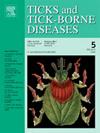原产于亚洲的斑纹透明瘤由候鸟传播到欧洲
IF 3.4
2区 医学
Q2 INFECTIOUS DISEASES
引用次数: 0
摘要
在非洲和中东地区,rufipes是最重要的流行病学蜱虫之一。它经常由候鸟传播,由于最近气候条件的变化,这些蜱虫有可能成为温带地区常住人口出现的来源。2023年5月,在罗马尼亚东南部采集了一只Hylomma sp.若虫,其寄主为具有已知迁徙路线的斑小麦耳(Oenanthe pleschanka)。根据它附着在中东沙特阿拉伯的鸟类宿主上的迁徙路线的时间,从形态学和遗传学上确定了这种蜱为红唇蜱。这是有史以来第一次记录在欧洲与已知的中东/亚洲起源。本文章由计算机程序翻译,如有差异,请以英文原文为准。
Hyalomma rufipes of Asian origin transported to Europe by a migrant bird
Hyalomma rufipes is one of the most epidemiologically important ticks in Africa and the Middle East. It is regularly transported by migratory birds and there are chances that these ticks may become sources for the emergence of resident populations in the temperate region due to recent changes in climatic conditions. In May 2023, a Hylomma sp. nymph was collected in SE Romania from a long-distance migrant host, the Pied Wheatear (Oenanthe pleschanka) with known migratory route. The tick was identified morphologically and genetically as H. rufipes and based on the timing of the migratory track it attached to its avian host in Saudi Arabia, the Middle East. This is the first ever H. rufipes recorded in Europe with known Middle Eastern/Asian origin.
求助全文
通过发布文献求助,成功后即可免费获取论文全文。
去求助
来源期刊

Ticks and Tick-borne Diseases
INFECTIOUS DISEASES-MICROBIOLOGY
CiteScore
6.90
自引率
12.50%
发文量
185
审稿时长
6-12 weeks
期刊介绍:
Ticks and Tick-borne Diseases is an international, peer-reviewed scientific journal. It publishes original research papers, short communications, state-of-the-art mini-reviews, letters to the editor, clinical-case studies, announcements of pertinent international meetings, and editorials.
The journal covers a broad spectrum and brings together various disciplines, for example, zoology, microbiology, molecular biology, genetics, mathematical modelling, veterinary and human medicine. Multidisciplinary approaches and the use of conventional and novel methods/methodologies (in the field and in the laboratory) are crucial for deeper understanding of the natural processes and human behaviour/activities that result in human or animal diseases and in economic effects of ticks and tick-borne pathogens. Such understanding is essential for management of tick populations and tick-borne diseases in an effective and environmentally acceptable manner.
 求助内容:
求助内容: 应助结果提醒方式:
应助结果提醒方式:


